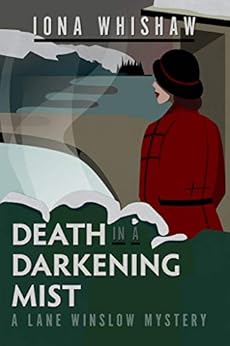3.5 Stars
Last year I read the first book in the Lane Winslow historical mystery series set in King’s Cove in interior British Columbia (https://schatjesshelves.blogspot.com/2020/03/review-of-killer-in-kings-cove-by-iona.html). I had been meaning to get back to the series because the first book showed promise, so when I was contacted by the publishing company, I accepted the offer of the next two books in the series in return for honest reviews. So here’s my review of the second installment; my review of the third book will be posted in four days.
In December of 1946, Lane is at a local hot springs when the body of a murdered man is discovered. The victim is a Russian who was living among the Doukhobors. Lane’s assistance is required because, having grown up in Latvia, she speaks Russian and so can serve as a translator. As the investigation is continued by Inspector Darling and Constable Ames, knowledge she acquired while working for British Secret Intelligence during the war provides valuable insight.
There are two sub-plots. One involves the embezzlement of money from accounts at the local bank. The second is the developing relationship between Lane and Inspector Darling.
As would be expected, there is further development of Lane. She is intelligent, compassionate and possesses a good sense of humour. She is also very independent and determined; these latter traits often lead her into difficulty and cause consternation in Darling because she dashes in heedlessly and then realizes she should have waited for the police. She’d be a terrible police officer because she tends not to wait for backup.
The characters introduced in the first novel, A Killer in King’s Cove, reappear. The village is populated with interesting, quirky people and readers familiar with them from the first book will enjoy seeing them again. The banter between Darling and Ames adds humour, and the conversations, often awkward, between Lane and Darling are always interesting.
I appreciated the references to historical events like the internment of Japanese-Canadians and the government’s treatment of the Doukhobors. I was inspired to do some additional research on the latter group about which I knew little. Constable Ames decides that Lane Winslow is Wonder Woman and that had me doing fact checking; the fictional superhero would indeed have been known because she was created during World War II.
There is one chapter, Chapter 21, which has a problem with chronology. In Chapter 17, Lane visits the bank and opens an account before she meets with Darling and Ames in Chapters 18, 19, and 20. In Chapter 21, we learn “there had been withdrawals three different times, quite close together, starting the day after [Lane had] made the deposit” . . . though “The last time she’d been in was when she had deposited the money.” Then, in Chapter 22, Darling speculates that Lane “should have gotten home by now” after opening the account and after meeting with them as described in Chapters 17 – 20. This lapse is irksome; it should have been noticed in the editing process.
This can be classified as a cozy historical mystery but it does have some elements of a spy thriller. I imagine these latter elements will continue as there is repeated reference to not being able to escape the past: “It was not quite enough to imagine one could escape to the back of beyond . . . and live an idyllic life free of every connection with the past” and “It does not matter what we do, she thought. What we wish for, what we believe. Fate will try, willy-nilly, to draw us along some appointed road.”
I’m off to read the next book to see what
next lies in wait for Lane Winslow. (Just
as I began reading this novel, an article written by Iona Whishaw came to my
attention; it indicates that Lane was inspired by the author’s mother: https://crimereads.com/a-family-of-spies/).

No comments:
Post a Comment